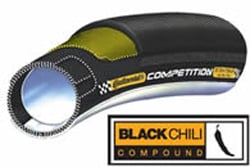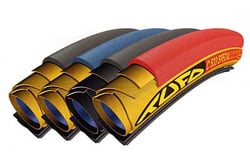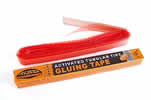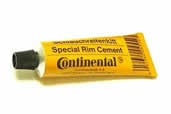Tubular Tires
Tubular tires, also known as sew-up tires, are an integrated system in which a casing and tread are wrapped around an inner tube and sewn together. They're then glued on to special rims. While the vast majority of cyclists ride clincher tires, tubular tires retain a devoted following of high end racers and cycling traditionalists. Until relatively recently, competitive cyclists raced exclusively on tubular tires. Traditionally, tubular tires offered a dramatic advantage in weight and rolling resistance over wire beaded clincher tires. Recently, tire manufacturers have dramatically closed the performance gap between clincher and tubular tires. Still, there are two big reasons to consider riding tubulars: flat resistance and ride quality.
Flat Resistance
Tubular tires are not susceptible to pinch flats. Pinch flats occur when the tube inside your clincher tire is pinched against an object, such as a curb or cyclocross barrier, and your rim. This leads to air being forced away from the pinched area causing friction that splits the tube. Tubular tires are able to employ a more resilient casing preventing the dramatic air transfer which causes pinch flats.
Ride Quality
The feature that draws most cycling traditionalists to tubular tires is their legendary ride quality. Tubular provide a "floating" ride feel. Corners that feel rough and jittery to a rider on clincher wheels are often smooth and comfortable with tubulars. While laboratory tests have found little evidence that indicates more efficient performance, those used to the feel of tubular tires have a hard time giving it up for the convenience of clinchers.
Manufacturers
Tubulars are a niche product, and not all bike tire manufacturers carry a tubular line. Michelin, for example, doesn't make any tubular tires, preferring to focus on their popular clinchers. That said, there are several brands that specialize in tubulars or focus a lot of research and development on them.
 Continental - This giant of the bike tire industry is also one of the most respected manufacturers of tubular tires. Their tubular line runs the gamut from ultra-durable training tires to high-performance, super-lightweight race tires. Continental also incorporates their Black Chili rubber compound in most of their tubular line, for lower rolling resistance and superior handling.
Continental - This giant of the bike tire industry is also one of the most respected manufacturers of tubular tires. Their tubular line runs the gamut from ultra-durable training tires to high-performance, super-lightweight race tires. Continental also incorporates their Black Chili rubber compound in most of their tubular line, for lower rolling resistance and superior handling.
Tufo - Tufo doesn't stand out just because of their brightly colored treads. Their "tubeless" tubular technology is unique in the industry. While Tufo's "tubeless" claim might be an oversimplification, their casings are in fact made with a latex lining which enables inflation, rather than traditional butyl. Tufo is a popular brand of tubulars due to their bright colors, high quality, and wide range of tires which, again, run from all-purpose training tires to the lightest race tubulars on the market.
Tufo is also a very popular manufacturer of cyclocross tires. Cyclocross riders are particularly loyal to tubular tires, thanks to their elimination of pinch flatting, and Tufo puts a great deal of thought into their 'cross line.
 Tufo has also expanded the boundaries of tubular tires with their tubular clincher line. Tubular clinchers are essentially tubular tires with a a hooked strip installed on the underside of the casing that allows them to be mounted on clincher rims. This allows owners of clincher wheels to enjoy the ride quality of tubulars without buying a new set of wheels. Please note: tubular clincher tires are only compatible with clincher rims!
Tufo has also expanded the boundaries of tubular tires with their tubular clincher line. Tubular clinchers are essentially tubular tires with a a hooked strip installed on the underside of the casing that allows them to be mounted on clincher rims. This allows owners of clincher wheels to enjoy the ride quality of tubulars without buying a new set of wheels. Please note: tubular clincher tires are only compatible with clincher rims!
Vittoria - This year I was fortunate enough to follow the Tour of California-the WHOLE race. I spent a fair amount of time poking around the team trucks and bugging the mechanics before stages. One thing I picked up on is that pros ride Vittoria tubulars. Teams sponsored by Vittoria ride them; teams not sponsored by Vittoria ride them. Some teams sponsored by other tire manufacturers ride it with a different brand stamped on the side. If pro cyclists not sponsored by the manufacturer go out of their way to use a certain product, it must be something special.
Installation

 Installation of tubulars is a somewhat delicate procedure. When not installed properly, a tire may detach from the rim during a ride-a very dangerous possibility. If it is your first time installing tubulars, consult a shop or experienced tubular rider to help with installation. Tubular installation is one of the archaic traditions of cycling, and many cyclists have their own preferences. Some riders stretch their tubulars before installing them. Some prefer to glue their tubulars with rim cement; others use gluing tape or a combination of the two. Some riders even age their tubulars, letting them sit in open air for up to a year before use.
Installation of tubulars is a somewhat delicate procedure. When not installed properly, a tire may detach from the rim during a ride-a very dangerous possibility. If it is your first time installing tubulars, consult a shop or experienced tubular rider to help with installation. Tubular installation is one of the archaic traditions of cycling, and many cyclists have their own preferences. Some riders stretch their tubulars before installing them. Some prefer to glue their tubulars with rim cement; others use gluing tape or a combination of the two. Some riders even age their tubulars, letting them sit in open air for up to a year before use.
Performance
While the performance gap between clinchers and tubulars constantly narrows, tubular tires still offer distinct performance advantages that make them the choice for competitive cyclists. Tubular wheelsets always weigh less than their clincher counterparts. Clincher rims generally add about 200 grams to the overall weight of the wheelset. Tubular tires can also be run at much more varied tire pressure than clinchers, which require enough pressure to secure the bead, but not so much it will blow the bead off the rim. Tubular tires can be run as low as 30 psi for the muddiest cyclocross races and as high as almost 200 psi for those fortunate enough to ride on the smoothest velodromes.
Ultimately, due to the dramatically lighter rims (where rotational weight matters most) tubular tires are going to provide a distinct advantage for many cyclists. The lighter the rim, the easier a wheel spins up to speed. And bike racing is all about acceleration. Once that acceleration has been made, the benefits of tubular wheels diminish, as aerodynamics play a much larger roll in maintaining speed. Comparable clincher and tubular wheelsets will have similar aerodynamic properties.
The benefits of tubulars will be felt mostly by riders that prefer rolling courses or hard climbs, where sudden accelerations from relatively low speeds often decide the race. Riders who shine on the climbs should definitely get out the glue. Flatlanders and time trial specialists might consider sticking with an aerodynamic clincher wheel. Clinchers will be less expensive and less of a hassle in the long run. That said, riders of all shapes, sizes, and inclinations can appreciate the incredible road feel of tubulars.
Repair
 Dealing with punctures in tubular tires is their primary downside. The use of sealant simplifies tubular repair. Tufo sealant can be applied before or after a tire flats by removing the presta valve core. Vittoria sells a product just blasts right on into the valve, no need to remove the core. Other manufacturers produce similar products to these; riders may want to experiment to find their favorite. If applied before inflating the tire, sealant will seal punctures quickly as they happen, preventing air loss; applied after a flat, the sealant will seal the leak upon reinflation. The major drawback of sealant is that it dramatically decreases the amount of air a tire can hold. After a tire has been sealed, we would advise running tire pressure less than 100 psi. Flats in tubulars generally compromise their use as a racing tire, though repaired tires can be ridden on for many miles at lower pressures.
Dealing with punctures in tubular tires is their primary downside. The use of sealant simplifies tubular repair. Tufo sealant can be applied before or after a tire flats by removing the presta valve core. Vittoria sells a product just blasts right on into the valve, no need to remove the core. Other manufacturers produce similar products to these; riders may want to experiment to find their favorite. If applied before inflating the tire, sealant will seal punctures quickly as they happen, preventing air loss; applied after a flat, the sealant will seal the leak upon reinflation. The major drawback of sealant is that it dramatically decreases the amount of air a tire can hold. After a tire has been sealed, we would advise running tire pressure less than 100 psi. Flats in tubulars generally compromise their use as a racing tire, though repaired tires can be ridden on for many miles at lower pressures.
It is theoretically possible to repair the tubes in some tubulars by breaking the fabric casing, repairing the inner tube and restitching the tire. However, we do not recommend repairing tubulars in this manner! Altering the fabric casing of a tubular can seriously impair the ability of the tire to bond with the rim. Neither WesternBikeworks.com nor tire manufacturers honor any warranties on tires with compromised casings, nor do we assume any liability for the failure of altered tires.
Please contact us at [email protected] or 1-800-651-4050 with any further questions regarding tubular tires, wheelsets or any other equipment.





